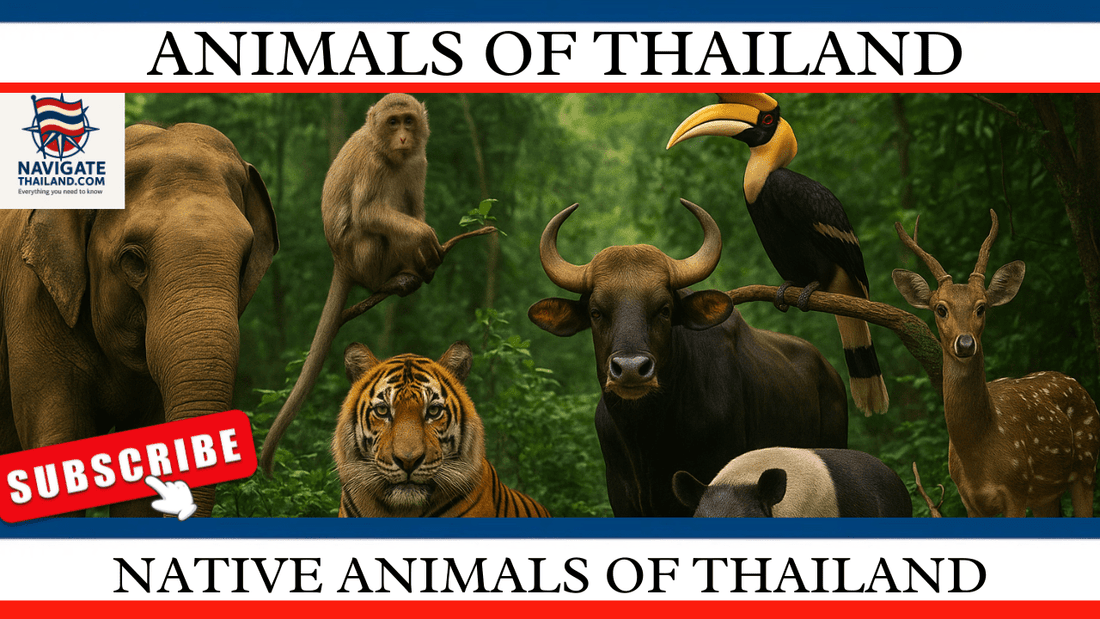
Native Animals of Thailand: A Rich and Diverse Wildlife
Share
Thailand is home to one of the most diverse ecosystems in Southeast Asia, boasting an incredible array of native animal species that thrive in its tropical rainforests, mangrove swamps, mountains, and coral reefs. From elusive jungle cats to brightly colored birds, the country’s wildlife reflects the rich biodiversity of the region. In this article, we will explore some of the most fascinating native animals of Thailand, their habitats, and the conservation efforts in place to protect them. Whether you are a wildlife enthusiast or a casual observer, Thailand’s native animals offer a glimpse into the wonders of nature that call this beautiful country home.
## Mammals of Thailand
Thailand’s native mammals are as diverse as its landscapes, with species ranging from large predators like tigers to small tree-dwelling primates. Many of these animals are found in Thailand’s national parks and wildlife sanctuaries, which provide vital habitats for their survival.
### 1. **Asian Elephant (Elephas maximus indicus)**
The Asian elephant is Thailand’s national animal and one of the most iconic species in Southeast Asia. These majestic creatures once roamed freely across the country, but their numbers have drastically declined due to habitat loss, poaching, and human-wildlife conflict. Wild elephants are mostly found in protected areas such as **Khao Yai National Park**, **Kui Buri National Park**, and the **Western Forest Complex**.
- **Habitat**: Tropical forests, grasslands, and lowland plains.
- **Conservation Status**: Endangered. Conservation efforts are ongoing, with several national parks and elephant sanctuaries focused on protecting wild elephant populations.
### 2. **Indochinese Tiger (Panthera tigris corbetti)**
Thailand is home to the Indochinese tiger, a subspecies of tiger that once roamed across much of Southeast Asia. Today, their population is critically endangered, and they are primarily found in the **Western Forest Complex**, particularly in **Huai Kha Khaeng Wildlife Sanctuary**. Indochinese tigers are top predators and play a crucial role in maintaining the balance of Thailand’s ecosystems.
- **Habitat**: Dense tropical forests and mountain ranges.
- **Conservation Status**: Endangered. Conservation efforts focus on anti-poaching patrols, habitat restoration, and increasing prey availability.
### 3. **Malayan Tapir (Tapirus indicus)**
The Malayan tapir is a unique herbivorous mammal that is native to the rainforests of Southern Thailand. Recognizable by its distinctive black-and-white coloring, the tapir is a distant relative of both horses and rhinos. Malayan tapirs are shy, nocturnal creatures that play a key role in seed dispersal within their forest habitats.
- **Habitat**: Lowland rainforests and montane forests.
- **Conservation Status**: Endangered. Deforestation and habitat fragmentation are major threats to tapir populations.
### 4. **Dusky Langur (Trachypithecus obscurus)**
The dusky langur, also known as the spectacled langur, is a tree-dwelling primate that inhabits the forests of southern Thailand. Known for their playful nature and wide-eyed expressions, these monkeys are often seen swinging from branch to branch in protected forest areas such as **Khao Sok National Park**.
- **Habitat**: Tropical rainforests, limestone cliffs, and mangroves.
- **Conservation Status**: Near Threatened. Habitat destruction due to logging and agriculture poses a significant threat to their survival.
### 5. **Leopard Cat (Prionailurus bengalensis)**
The leopard cat is one of Thailand’s most adaptable small carnivores. Found throughout Thailand’s forests, grasslands, and agricultural areas, this nocturnal hunter preys on small mammals, birds, and reptiles. Although it resembles a miniature leopard, it is much smaller and generally elusive.
- **Habitat**: Forests, grasslands, and agricultural areas.
- **Conservation Status**: Least Concern, though habitat loss and hunting are ongoing concerns.
## Birds of Thailand
Thailand’s birdlife is just as diverse as its mammals, with over 1,000 recorded species across the country. From colorful tropical birds to impressive raptors, Thailand is a paradise for birdwatchers and ornithologists alike.
### 1. **Great Hornbill (Buceros bicornis)**
The great hornbill is one of Thailand’s most striking birds, known for its massive yellow beak and impressive wingspan. These large birds are found in Thailand’s dense forests and are particularly common in national parks like **Khao Yai** and **Kaeng Krachan**. The hornbill’s unique call and elaborate courtship displays make it a favorite among wildlife enthusiasts.
- **Habitat**: Tropical rainforests and evergreen forests.
- **Conservation Status**: Near Threatened. Deforestation is the greatest threat to their survival, as they require large, mature trees for nesting.
### 2. **Siamese Fireback (Lophura diardi)**
The Siamese fireback, Thailand’s national bird, is a stunning pheasant known for its iridescent plumage and striking tail feathers. These birds are found in the lowland forests of central and eastern Thailand and are often seen in protected areas such as **Khao Yai National Park**. The males are particularly striking with their glossy blue-gray bodies and vivid red facial wattles.
- **Habitat**: Lowland and evergreen forests.
- **Conservation Status**: Least Concern, but habitat loss remains an issue.
### 3. **Asian Fairy Bluebird (Irena puella)**
The Asian fairy bluebird is a small but brilliantly colored bird, with males sporting vibrant blue feathers and females displaying more muted green tones. These birds are typically found in tropical and subtropical forests, where they feed on fruit and insects.
- **Habitat**: Tropical and subtropical forests, particularly in southern Thailand.
- **Conservation Status**: Least Concern.
## Reptiles and Amphibians of Thailand
Thailand’s warm climate and lush rainforests are also home to a variety of reptiles and amphibians, some of which are unique to the region.
### 1. **King Cobra (Ophiophagus hannah)**
The king cobra, the world’s longest venomous snake, is native to Thailand and is one of the most feared reptiles in the country. Despite their fearsome reputation, king cobras generally avoid human contact. They can grow up to 18 feet in length and primarily prey on other snakes.
- **Habitat**: Forests, bamboo thickets, and agricultural areas.
- **Conservation Status**: Vulnerable. Habitat loss and illegal hunting for the pet trade are the main threats.
### 2. **Reticulated Python (Malayopython reticulatus)**
The reticulated python is another of Thailand’s large reptiles and one of the world’s longest snakes. These non-venomous constrictors are native to Southeast Asia and are often found in Thailand’s rainforests and mangrove swamps. They are skilled hunters and prey on a variety of animals, including small mammals and birds.
- **Habitat**: Rainforests, mangroves, and wetlands.
- **Conservation Status**: Least Concern, though habitat loss is a concern.
### 3. **Tokay Gecko (Gekko gecko)**
The tokay gecko is one of Thailand’s most recognizable reptiles, known for its striking coloration and loud, distinctive call. These nocturnal lizards are often seen clinging to walls and ceilings in rural homes and urban areas. They are also common in forests and can be found across Thailand.
- **Habitat**: Forests, urban areas, and agricultural regions.
- **Conservation Status**: Least Concern, though they are hunted for the pet trade.
## Marine Life of Thailand
Thailand’s coastline and islands are home to some of the richest marine ecosystems in the world. The coral reefs of the Andaman Sea and the Gulf of Thailand are teeming with marine life, from tiny seahorses to majestic whale sharks.
### 1. **Whale Shark (Rhincodon typus)**
The whale shark, the largest fish in the world, can occasionally be spotted in Thailand’s waters, particularly around the Similan Islands and Koh Tao. Despite their size, whale sharks are filter feeders and pose no threat to humans. These gentle giants are a popular attraction for divers and snorkelers.
- **Habitat**: Warm, tropical waters, particularly around coral reefs.
- **Conservation Status**: Endangered, primarily due to overfishing and habitat degradation.
### 2. **Hawksbill Sea Turtle (Eretmochelys imbricata)**
The hawksbill sea turtle is a critically endangered species that nests on Thailand’s beaches and forages along its coral reefs. These turtles play an important role in maintaining the health of coral reef ecosystems by controlling sponges and algae growth.
- **Habitat**: Coral reefs and coastal waters.
- **Conservation Status**: Critically Endangered. Conservation programs focus on protecting nesting sites and reducing plastic pollution.
### 3. **Clownfish (Amphiprioninae)**
Thailand’s coral reefs are home to the brightly colored clownfish, made famous by the movie *Finding Nemo*. These small fish live among sea anemones, forming a symbiotic relationship where the fish are protected by the anemone’s stinging tentacles, and in return, the clownfish help keep the anemone clean.
- **Habitat**: Coral reefs, particularly in the Andaman Sea and the Gulf of Thailand.
- **Conservation Status**: Least Concern, though coral reef degradation poses a threat.
## Conclusion
Thailand’s native animals are a vital part of the country’s rich biodiversity and natural heritage. From the mighty Asian elephant to the elusive Indochinese tiger and the colorful array of birds and marine life, these animals contribute to Thailand’s unique ecosystems. However, many of these species are under threat from habitat loss, poaching, and human-wildlife conflict. Conservation efforts, such as protected national parks, wildlife sanctuaries, and anti-poaching patrols, are essential in preserving Thailand’s diverse wildlife for future generations.
---
## References:
1. Lair, R. C. (1997). **Gone Astray: The Care and Management of the Asian Elephant in Domesticity**. FAO.
2. Baker, C., & Phongpaichit, P. (2009). **A History of Thailand**. Cambridge University Press.
3. Lekagul, B., & McNeely, J. A. (1977). **Mammals of Thailand**. Association for the Conservation of Wildlife.
4. WildAid. (2020). **Thailand Wildlife Conservation Efforts**.
5. Wildlife Conservation Society (WCS) Thailand. (2020). **Tiger Conservation Program in Thailand**. WCS Thailand.
Read more of our Thailand blog series:
Thai Food Guide:Traditional Recipes and Street Eats
Everything Travellers Need to know
Thailand travel ebooks and language guides
Thailand Travel Apparel & Souvenir Gifts
Subscribe to our YouTube channel Navigate Thailand to see our most popular Thailand travel blogs turned into videos:
Navigate Thailand YouTube channel










































































































































